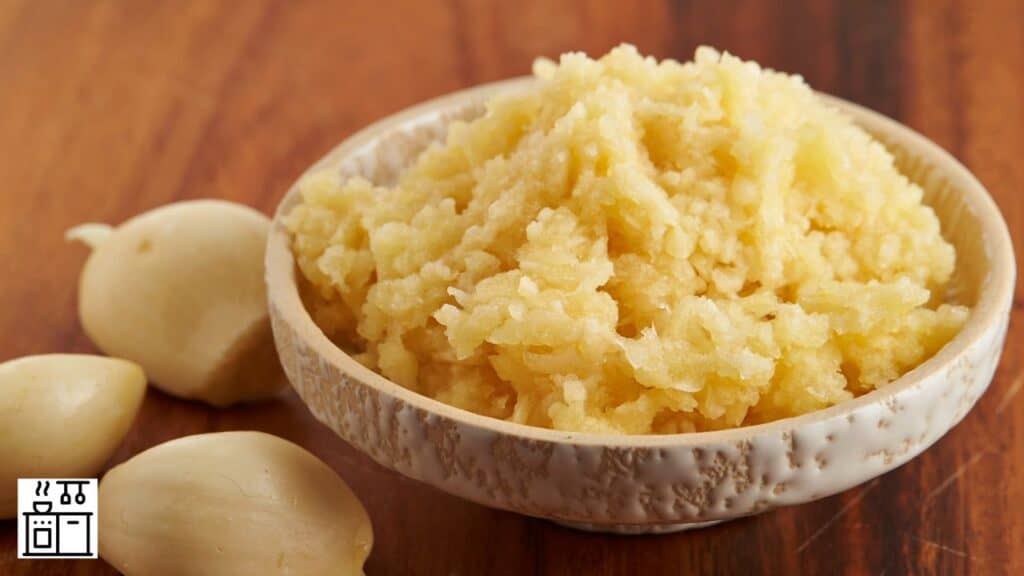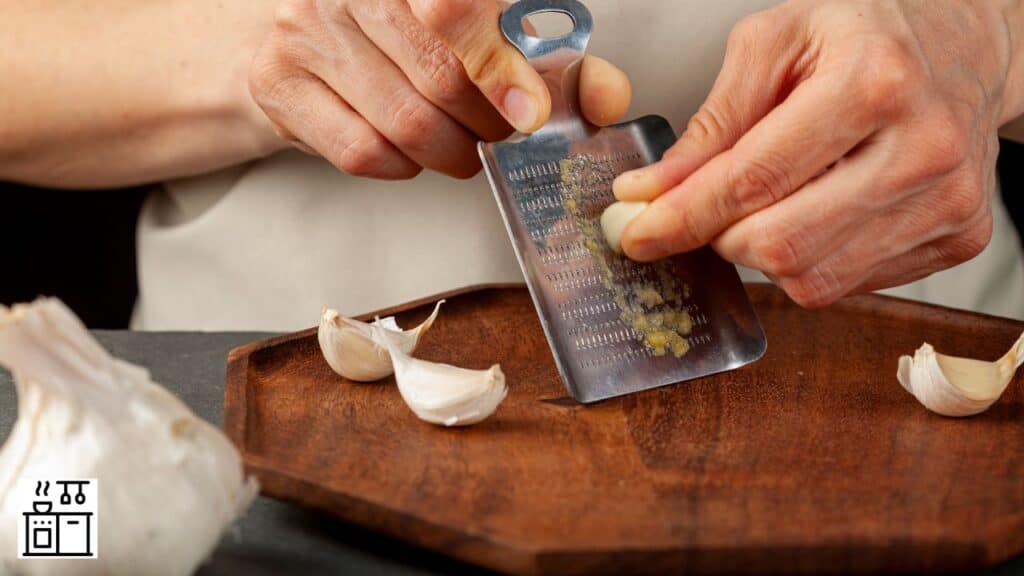To grate garlic, angle the garlic grater over a cutting board or bowl to catch the grated garlic. Then, rub the peeled garlic clove against the grater with enough pressure to grate the garlic.
You can also grate garlic by putting the flat side of a knife on the garlic clove and applying gentle pressure. The skin will crack and peel off easily. Once the garlic is peeled, use a grating tool, like a Microplane, box grater, or garlic grater to grate the garlic.
Be mindful not to cut your fingers, especially as the clove becomes smaller. After grating the required amount, it’s ready for use.
Let’s now talk about the various ways to grate garlic. But first…
What Is Grated Garlic?
Grated garlic is simply garlic cloves that have been rubbed against a grating surface to create a fine, paste-like texture.
It’s a processed form of garlic frequently used in cooking to provide a strong, garlicky flavor. It’s typically made using a Microplane or a box grater.
Grated garlic has several advantages over minced garlic:
- Consistency: Grated garlic has a uniform texture, allowing it to blend smoothly into sauces, dressings, and marinades without leaving chunks.
- Flavor: Grating releases more garlic oils, yielding a stronger taste.
- Time: Grating is faster and less work than mincing, making it a good choice when time is limited.
- Versatility: Grated garlic can be used in various recipes, such as pasta, stir-fries, soups, and roasts.
What Are the Different Tools for Grating Garlic?
If your recipe requires freshly grated garlic, you need to know the right tools for this task.
Here are different utensils for grating garlic effectively.
1. Microplane
A Microplane is an excellent tool for quickly and effortlessly grating garlic. It has ultra-sharp blades for smooth grating and an ergonomic handle for comfort. It’s not only useful for grating but also for zesting and slicing garlic.
The Microplane stands out for its:
- Ultra-sharp blades: These ensure a seamless grating process.
- Ergonomic handle: It provides a comfortable grip.
- Durability: The Microplane is a long-lasting tool, offering value for money.
- Versatility: Microplane is not just for garlic – you can also use it with ginger.
2. Garlic Grater
A garlic grater is a small plate-like tool with raised teeth or ridges. Rubbing a garlic clove against these ridges turns it into a fine paste, resulting in a stronger flavor than minced garlic.
Garlic graters are made of various materials such as ceramic and stainless steel. Some graters come with additional accessories like a small brush for collecting the grated garlic or a silicone peeler for removing the skin.
A garlic grater is a useful kitchen tool that simplifies the garlic grating process.
3. Box Grater
Moving on from garlic graters, let’s talk about the box grater. This four-sided utensil has multiple uses. It’s not just for grating cheese. It has different grating surfaces for various tasks.
- The large holes are used for grating cheese and vegetables.
- The small holes finely shred potatoes, cabbage, and carrots.
- The rough, raspy side is used for zesting citrus fruits.
- The slicer side easily slices cucumbers or potatoes.
So you don’t have to worry if you don’t have a garlic grater. A box grater can grate garlic efficiently.
4. Garlic Press
A garlic press is a useful kitchen tool that quickly crushes garlic cloves. It’s not a grater, but it can produce a similar effect.
To use a garlic press, place a peeled garlic clove in its chamber and squeeze the handles. The result is a fine, paste-like garlic that’s ideal for cooking.
The garlic press grates the garlic for you, producing a flavorful paste that enhances your dishes. It saves time and prevents the garlic smell on your hands.
5. Chef’s Knife
A chef’s knife is a versatile tool, ideal for precise slicing, dicing, and chopping. Initially created for large cuts of beef, this knife is now a staple for most Western cooks.
It typically has a blade that’s 8 inches long and 1.5 inches wide, suitable for various kitchen tasks.
A chef’s knife can also efficiently grate garlic, serving as a good substitute for a garlic press.
Follow these steps to grate garlic using a Chef’s knife:
- Peel the garlic clove.
- Place the flat side of the Chef’s knife on the clove.
- Apply pressure to crush the clove.
- Chop the crushed garlic until you reach your preferred consistency.
5. Fork
The fork is not only a utensil for eating but also a useful tool for preparing food. Its multiple tines make it ideal for spearing food, and helping in cutting or lifting.
For example, a carving fork helps in carving a slice of roast, while a dessert fork is used to enjoy sweet dishes.
There are various types of forks, each designed for a specific use.
| Type | Size | Use |
|---|---|---|
| Table Fork | Medium | Used for main courses |
| Salad Fork | Small | Used for salads |
| Dessert Fork | Small | Used for desserts |
| Carving Fork | Large | Used for carving meats |
How to Use a Microplane for Grating Garlic?

Start by peeling the garlic clove to reveal the fresh garlic inside. Then, hold the Microplane at a slight angle over a cutting board or bowl. This way, the grated garlic will fall neatly onto the surface below and not scatter around.
To grate, gently rub the peeled garlic clove against the Microplane’s sharp surface. Be careful as the blades are sharp and could cut your finger.
Apply just enough pressure to break down the garlic, but not too much to avoid making garlic juice. Aim for a paste-like consistency.
After grating, gather your garlic. It should be finely grated and perfect for your recipe.
Keep in mind that fresh garlic has a more potent flavor than pre-packaged minced garlic, so you might need to adjust your recipe.
How to Use a Garlic Grater for Grating Garlic?
To use a garlic grater for grating garlic, first wet its surface with cold water or a bit of olive oil. This creates a smooth surface for the garlic to slide on, making grating easier.
Next, peel the garlic clove to reveal the fresh garlic. Ensure that the grater is secure on a flat surface and hold it around the edges to prevent accidents.
Now, grate the garlic. Hold the peeled clove between your thumb and index finger, with the root end up. Rub the clove on the grater until you reach the root end, which you should discard as it’s too acidic.
After grating, you’ll have a fine garlic paste that’s more flavorful than minced garlic. Use a small stiff brush to clean the grater and collect the paste for your recipe.
Here’s the process in a table:
| Steps | Description | Tips |
|---|---|---|
| Wet the grater | Use cold water or olive oil | Enables easy grating |
| Peel the garlic | Remove the outer skin | Reveals fresh garlic |
| Grate the garlic | Rub the clove on the grater | Produces fine paste |
How to Use a Box Grater for Grating Garlic?
Using a box grater to grate garlic cloves is an effective and quick method.
This common kitchen tool can also be used for grating garlic, not just cheese or vegetables. It’s especially useful when you’re short on time or need a large quantity of garlic.
Follow these steps to grate garlic using a box grater:
- Peel the garlic: First, remove the outer skin of the garlic clove to expose the fresh garlic.
- Secure the box grater: Place the box grater on a stable surface such as a cutting board. Hold it firmly with one hand to prevent it from slipping or moving while grating.
- Grate the garlic: Use the smallest holes on the box grater to grate the garlic. Gently rub your peeled garlic clove against the grater, moving it up and down with enough pressure to grate it without risking your fingers.
- Collect the garlic: After grating, collect the garlic. It should have a fine, paste-like consistency, ready to be used in your recipe.
This method is efficient and yields a perfect consistency.
How to Use a Garlic Press for Grating Garlic?
Using a garlic press for grating garlic simplifies the process and saves time. Here’s a straightforward way to use it.
First, peel your garlic clove to reveal the fresh garlic. This involves simply removing the outer skin.
Next, place the peeled garlic clove into the chamber of the garlic press. The design of the press ensures that the garlic clove stays in place.
Then, with the garlic press over a bowl or your dish, squeeze the handles together. This action crushes the garlic clove, pushing it through the small holes in the press.
The result is finely grated garlic, ready for your recipe. The garlic press does the grating work for you, delivering fresh garlic in a convenient manner.
How to Grate Garlic without A Grater?
If you need to grate garlic but don’t have a grater, don’t worry.
You can use other tools in your kitchen such as a chef’s knife or a fork.
These can effectively grate your garlic.
How to Use a Chef’s Knife for Grating Garlic?
Grating garlic may not be a common use for a chef’s knife, but it yields a similar outcome.
Follow these steps to grate garlic using a Chef’s knife:
- Peel the garlic clove.
- Place the flat side of the Chef’s knife on the clove.
- Apply pressure to crush the clove.
- Chop the crushed garlic until you reach your preferred consistency.
How to Use a Fork for Grating Garlic?
A fork can be used to grate garlic into a fine paste.
First, peel the garlic clove. Then, position the fork on a cutting board with its tines slightly raised.
Hold the peeled garlic between your thumb and index finger, and rub it over the fork tines. This will turn the garlic into a paste-like consistency.
Once grated, gather the garlic from the cutting board or bowl for use in your recipe.
This is a straightforward way to grate garlic using a common kitchen utensil.

